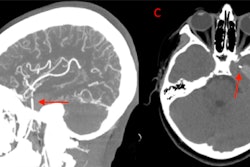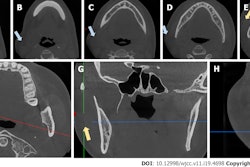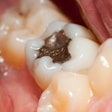A woman died hours after developing an air embolism induced by an air syringe used during a routine dental restoration procedure to treat tooth decay, according to a new case report published on July 5 in Legal Medicine.
The authors believe the 70-year-old woman’s past dental treatment and the presence of an unusual anatomical feature made her more susceptible to developing an air embolism.
“Air embolism during dental treatment is a rare but potentially fatal complication,” wrote the authors, led by Rie Sano of the faculty of life sciences at Kumamoto University in Japan.
A 70-year-old woman with caries, apical periodontitis
The patient, who had a history of high blood pressure, high cholesterol, hay fever, and osteoporosis, went to the dentist with third-degree caries and apical periodontitis in her lower right second molar. In the past, she had undergone a root canal, abutment construction, and full metal crown placement. Subsequently, three restorative treatments were performed on the lower right second molar.
On her most recent visit, restorative treatment was performed for her third-degree caries after dental scaling. The cavity preparation was performed using an air turbine equipped with a diamond point, and the restoration was air-dried using an air syringe.
During the treatment, the woman stiffened and lost consciousness. CPR was performed, but about 10 minutes later, when emergency personnel arrived, she was in cardiac and respiratory arrest, according to the report. The woman was taken to the hospital where she died about two hours later.
About 21 hours after her death, computed tomography images were taken, revealing subcutaneous emphysema from the right mandible to the cervical area. Also, gas was visible in the right mandibular canal, the right submental vein extending to the right anterior jugular vein, in the brain, cervical vessels, and chambers of the heart. It was estimated that about 100 mL of gas within the heart chambers, the authors wrote.
An autopsy revealed gas within the woman’s cerebral and anterior jugular veins and emphysema in the cervical soft tissues. A 0.5-cm patent foramen ovale was discovered in her atrial septum, they wrote.
“These findings indicated sudden death associated with air embolism because no other fatal pathological lesions, such as ischemic heart disease or cerebral hemorrhage, were observed,” the authors wrote.
What likely led to this tragedy
This rare case can be traced back to two factors.
First, the woman’s past dental treatment affected her gum tissue, causing delicate granulation tissue to form and making her more susceptible to air infiltration. The fragile gum tissue likely allowed air from the dental device to enter the area around her tooth, the authors wrote.
Second, the patient had a patent foramen ovale, a small opening between the heart’s two upper chambers. In most people, this hole closes shortly after they’re born. This type of anomaly can create a straight path for air to pass from a person’s venous system to the arterial system, they wrote.
“In conclusion, this report describes a 70-year-old woman who succumbed to an air embolism that was probably induced by an air turbine or air syringe during a dental procedure,” Sano and colleagues wrote.




















